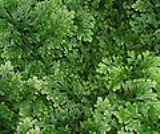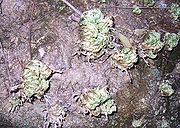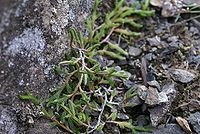
Spikemoss
Encyclopedia


Lycopodiopsida
Lycopodiopsida is a class of plants often loosely grouped as the fern allies. Traditionally the group included not only the clubmosses and firmosses, but also the spikemosses and the quillworts...
(often misconstructed as "Lycopsida"). This group of plants has for years been included in what, for convenience, was called "fern allies
Fern ally
Fern allies are a diverse group of seedless vascular plants that are not true ferns. Like ferns, a fern ally disperses by shedding spores to initiate an alternation of generations.-Classification:...
". S. moellendorffii
Selaginella moellendorffii
Selaginella moellendorffii is a lycophyte that is an important model organism, especially in comparative genomics. S. moellendorffii is a member of an ancient vascular plant lineage that first appears in the fossil record some 400 million years ago. They would later form a dominant part of the...
is an important model organism
Model organism
A model organism is a non-human species that is extensively studied to understand particular biological phenomena, with the expectation that discoveries made in the organism model will provide insight into the workings of other organisms. Model organisms are in vivo models and are widely used to...
, and its genome was sequenced by the United States Department of Energy
United States Department of Energy
The United States Department of Energy is a Cabinet-level department of the United States government concerned with the United States' policies regarding energy and safety in handling nuclear material...
's Joint Genome Institute
Joint Genome Institute
The U.S. Department of Energy Joint Genome Institute was created in 1997 to unite the expertise and resources in genome mapping, DNA sequencing, technology development, and information sciences pioneered at the DOE genome centers at Lawrence Berkeley National Laboratory , Lawrence Livermore...
.
Characteristics
Selaginellas are creeping or ascendant plants with simple, scale-like leaves on branching stems from which roots also arise. The plants are heterosporousSpore
In biology, a spore is a reproductive structure that is adapted for dispersal and surviving for extended periods of time in unfavorable conditions. Spores form part of the life cycles of many bacteria, plants, algae, fungi and some protozoa. According to scientist Dr...
(megaspores and microspores), and have structures called ligules, scale-like outgrowths near the base of the upper surface of each microphyll
Microphyll
The terminology of fossil plants is in places a little confusing. In the discipline's 200+ year history, certain concepts have become entrenched, even though improved understanding has threatened the foundations upon which they are based...
and sporophyll.
Unusually for the lycopods, each microphyll contains a branching vascular trace.
Generic division
Some modern authors recognize three generic divisions of Selaginella: Selaginella, Bryodesma Sojak 1992, and Lycopodioides Boehm 1760. Lycopodioides would include the native North American species S. apoda and S. eclipes, while Bryodesma would include the native S. rupestris (as Bryodesma rupestre). Stachygynandrum is also sometimes used to include the bulk of species.The first major attempt to define and subdivide the group was by Palisot de Beauvois
Palisot de Beauvois
Ambroise Marie François Joseph Palisot, Baron de Beauvois 27 July 1752 Arras - 21 January 1820 Paris, was a French naturalist.Palisot collected insects in Oware, Benin, Saint Domingue, and the United States, during the period 1786 – 1797. Trained as a botanist, Palisot published a significant...
in 1803-1805. He established the genus Selaginella as a monotypic genus, and placed the bulk of species in Stachygynandrum. Gymnogynum was another monotypic genus, but that name is superseded by his own earlier name of Didiclis. This turns out, today, to be a group of around 45-50 species also known as the Articulatae, since his Didiclis/Gymnogynum genus was based on Selaginella plumosa. He also described the genus Diplostachyum to include a group of species similar to Selaginella apoda. Spring
Antoine Frédéric Spring
Antoine Frédéric Spring was a German-born, Belgian physician and botanist.Trained as a physician, he was a professor of physiology and pathology at the University of Liège. As a botanist he specialized in research of Lycopodiaceae and Selaginellaceae...
inflated the genus Selaginella to hold all selaginelloid species four decades later.
Phylogenetic studies by Korall & Kenrick determined that the Euselaginella group, comprising solely the type species, Selaginella selaginoides
Selaginella selaginoides
Selaginella selaginoides is a non-flowering plant of the spikemoss genus Selaginella with a wide distribution around the Northern Hemisphere. It resembles a moss in appearance but is a vascular plant belonging to the division Lycopodiophyta...
and a closely related Hawai'ian species, Selaginella deflexa, is a basal and anciently diverging sister to all other Selaginella species. Beyond this, their study split the remainder of species into two broad groups, one including the Bryodesma species, the Articulatae, section Ericetorum Jermy and others, and the other centered around the broad Stachygynandrum group.
In the Manual of Pteridology, the following classification was used by Walton & Alston:
genus: Selaginella
- subgenus: Euselaginella
- group: selaginoides
- group: pygmaea
- group: uliginosa (Ericetorum)
- group: rupestris (Tetragonostachys or Bryodesma)
- subgenus: Stachygynandrum
- series: Decumbentes
- series: Ascendentes
- series: Sarmentosae
- series: Caulescentes
- series: Circinatae
- series: Articulatae
- subgenus: Homostachys
- subgenus: Heterostachys
Species
There are about 700 species of Selaginella, showing a wide range of characters; the genus is overdue for a revision which might include subdivision into several genera. Better-known spikemosses include:- Selaginella apodaSelaginella apodaSelaginella apoda, commonly known as meadow spike-moss, is a lycophyte native to much of the eastern United States and parts of northeastern Mexico. It is found primarily in damp soils in habitats such as swamps, wet fields, open woods and along stream banks. A lowland plant, it has only been...
- meadow spikemoss (eastern North AmericaNorth AmericaNorth America is a continent wholly within the Northern Hemisphere and almost wholly within the Western Hemisphere. It is also considered a northern subcontinent of the Americas...
) - Selaginella arizonica Maxon (west Texas to Arizona and Sonora, Mexico)
- Selaginella asprellaSelaginella asprellaSelaginella asprella is a species of spikemoss known by the common name bluish spikemoss. It is native to California and Baja California, where it has a disjunct distribution, occurring in the Klamath Mountains and mountain ranges several hundred miles to the south. It grows in rocky mountainous...
- Selaginella bifidaSelaginella bifidaSelaginella bifida is a lycophyte native to Rodrigues Island in the Mascarene Islands. It was found firstly in 1991 on the Mont Limon at 20–150 m high and was confused with S. rodrigueziana Baker because of their strong phenotypical homologies...
(Rodrigues Island) - Selaginella biformisSelaginella biformisSelaginella biformis is a species of plant in the Selaginellaceae family.-References:*Martha A. Dahlen, . Taxonomy of Selaginella: a study of characters, techniques, and classification in the Hong Kong species. Botanical Journal of the Linnean Society, Volume 98 Issue 4, Pages 277 - 302....
- Selaginella bigeloviiSelaginella bigeloviiSelaginella bigelovii is a species of spikemoss known by the common names bushy spikemoss and Bigelow's spikemoss. It is native to California and Baja California, where it grows in rocky places in many different habitat types, from the coastline to the mountains to the deserts...
- Selaginella braunii - Braun's spikemoss (ChinaChinaChinese civilization may refer to:* China for more general discussion of the country.* Chinese culture* Greater China, the transnational community of ethnic Chinese.* History of China* Sinosphere, the area historically affected by Chinese culture...
) - Selaginella bryopteris - sanjeevani (IndiaIndiaIndia , officially the Republic of India , is a country in South Asia. It is the seventh-largest country by geographical area, the second-most populous country with over 1.2 billion people, and the most populous democracy in the world...
) - Selaginella canaliculata - clubmoss (southeast AsiaSoutheast AsiaSoutheast Asia, South-East Asia, South East Asia or Southeastern Asia is a subregion of Asia, consisting of the countries that are geographically south of China, east of India, west of New Guinea and north of Australia. The region lies on the intersection of geological plates, with heavy seismic...
, Maluku IslandsMaluku IslandsThe Maluku Islands are an archipelago that is part of Indonesia, and part of the larger Maritime Southeast Asia region. Tectonically they are located on the Halmahera Plate within the Molucca Sea Collision Zone...
) - Selaginella carinataSelaginella carinataSelaginella carinata is a species of plant in the Selaginellaceae family. It is endemic to Ecuador. Its natural habitat is subtropical or tropical moist montanes. It is threatened by habitat loss.-Source:...
- Selaginella cinerascensSelaginella cinerascensSelaginella cinerascens is a species of spikemoss known by the common names ashy spikemoss, gray spikemoss, and mesa spikemoss. It is native to Baja California as well as some locations just north of the border in San Diego County, California. It grows in dry habitat, often on clay soil, both in...
- Selaginella densaSelaginella densaSelaginella densa is a species of spikemoss known by the common names lesser spikemoss, prairie spikemoss, and Rocky Mountains spikemoss...
- lesser spikemoss (western North America) - Selaginella eclipes - hidden spikemoss (eastern North America)
- Selaginella elmeriSelaginella elmeriSelaginella elmeri is a species of plant in the Selaginellaceae family....
- Selaginella eremophilaSelaginella eremophilaSelaginella eremophila is a species of spikemoss known by the common name desert spikemoss. It is native to the deserts and adjacent mountains around the intersection of California and Arizona with Baja California. It grows in sandy and rocky habitat. This lycophyte forms dense mats of spreading...
Maxon - Selaginella hanseniiSelaginella hanseniiSelaginella hansenii is a species of spikemoss known by the common name Hansen's spikemoss. It is endemic to California where it can be found throughout the central part of the state, from the lowest reaches of the Cascade Range through the Central Coast Ranges and Sierra Nevada to the southern end...
- Selaginella kraussianaSelaginella kraussianaSelaginella kraussiana, sometimes known by the common names of Krauss's spikemoss and African clubmoss, is a clubmoss found naturally in the Canary Islands, the Azores and parts of mainland Africa .-Invasive plant:...
- Krauss's spikemoss (AfricaAfricaAfrica is the world's second largest and second most populous continent, after Asia. At about 30.2 million km² including adjacent islands, it covers 6% of the Earth's total surface area and 20.4% of the total land area...
, AzoresAzoresThe Archipelago of the Azores is composed of nine volcanic islands situated in the middle of the North Atlantic Ocean, and is located about west from Lisbon and about east from the east coast of North America. The islands, and their economic exclusion zone, form the Autonomous Region of the...
) - Selaginella lepidophyllaSelaginella lepidophyllaSelaginella lepidophylla is a species of desert plant in the spikemoss family . S. lepidophylla is noted for its ability to survive almost complete desiccation; during dry weather in its native habitat, its stems curl into a tight ball and uncurl when exposed to moisture...
- resurrection plant, dinosaur plant, and flower of stone (Chihuahuan DesertChihuahuan DesertThe Chihuahuan Desert is a desert, and an ecoregion designation, that straddles the U.S.-Mexico border in the central and northern portions of the Mexican Plateau, bordered on the west by the extensive Sierra Madre Occidental range, and overlaying northern portions of the east range, the Sierra...
of North AmericaNorth AmericaNorth America is a continent wholly within the Northern Hemisphere and almost wholly within the Western Hemisphere. It is also considered a northern subcontinent of the Americas...
) - Selaginella martensiiSelaginella martensiiSelaginella martensii is a lycophyte in the Selaginellaceae family. It is native to Mexico and Central America.-References:* * *...
- variegated spikemoss - Selaginella moellendorffiiSelaginella moellendorffiiSelaginella moellendorffii is a lycophyte that is an important model organism, especially in comparative genomics. S. moellendorffii is a member of an ancient vascular plant lineage that first appears in the fossil record some 400 million years ago. They would later form a dominant part of the...
- Selaginella oreganaSelaginella oreganaSelaginella oregana is a species of spikemoss known by the common name Oregon spikemoss. It is native to the Pacific Coast of western North America, where it can be found from British Columbia to northern California. It grows in mossy, shady coastal forests. It is often epiphytic, growing attached...
- Selaginella poulteriSelaginella poulteriSelaginella poulteri is a species of plant in the Selaginellaceae family....
- Selaginella pulcherrimaSelaginella pulcherrimaSelaginella pulcherrima is a species of plant in the Selaginellaceae family....
- Selaginella rupestrisSelaginella rupestrisSelaginella rupestris is a species of spike-moss occurring in dry rocky places in eastern North America, including one locality in Greenland. It has a wide but sporadic range.-External links:*...
- rock spikemoss, festoon pine, and northern Selaginella (eastern North America) - Selaginella rupincola Underw. west Texas to Arizona and Sonora, Mexico
- Selaginella selaginoidesSelaginella selaginoidesSelaginella selaginoides is a non-flowering plant of the spikemoss genus Selaginella with a wide distribution around the Northern Hemisphere. It resembles a moss in appearance but is a vascular plant belonging to the division Lycopodiophyta...
- lesser clubmoss (north temperate EuropeEuropeEurope is, by convention, one of the world's seven continents. Comprising the westernmost peninsula of Eurasia, Europe is generally 'divided' from Asia to its east by the watershed divides of the Ural and Caucasus Mountains, the Ural River, the Caspian and Black Seas, and the waterways connecting...
, AsiaAsiaAsia is the world's largest and most populous continent, located primarily in the eastern and northern hemispheres. It covers 8.7% of the Earth's total surface area and with approximately 3.879 billion people, it hosts 60% of the world's current human population...
and North AmericaNorth AmericaNorth America is a continent wholly within the Northern Hemisphere and almost wholly within the Western Hemisphere. It is also considered a northern subcontinent of the Americas...
) - Selaginella sericeaSelaginella sericeaSelaginella sericea is a species of plant in the Selaginellaceae family. It is endemic to Ecuador. Its natural habitats are subtropical or tropical moist lowland forests and subtropical or tropical moist montanes. It is threatened by habitat loss....
A.Braun - EcuadorEcuadorEcuador , officially the Republic of Ecuador is a representative democratic republic in South America, bordered by Colombia on the north, Peru on the east and south, and by the Pacific Ocean to the west. It is one of only two countries in South America, along with Chile, that do not have a border... - Selaginella serpensSelaginella serpensSelaginella serpens is a species of plant in the Selaginellaceae family....
- Selaginella uliginosaSelaginella uliginosaSelaginella uliginosa is a small perennial plant found in Australia. An ancient and primitive plant, usually under 10 centimetres tall, it is often seen in sunny moist areas. The specific epithet uliginosa is from Latin, referring to the plant's preference to grow in swampy locations....
AustraliaAustraliaAustralia , officially the Commonwealth of Australia, is a country in the Southern Hemisphere comprising the mainland of the Australian continent, the island of Tasmania, and numerous smaller islands in the Indian and Pacific Oceans. It is the world's sixth-largest country by total area... - Selaginella umbrosaSelaginella umbrosaSelaginella umbrosa is a species of plant in the Selaginellaceae family....
- Selaginella uncinataSelaginella uncinataSelaginella uncinata is a species of plant in the Selaginellaceae family....
- peacock moss, peacock spikemoss, blue spikemoss - Selaginella underwoodii Hieron. west Texas to Wyoming and west into Arizona
- Selaginella wallaceiSelaginella wallaceiSelaginella wallacei is a species of spikemoss known by the common name Wallace's spikemoss. It is native to western North America from British Columbia to California to Montana, where it can be found in many types of habitat, including open and shaded areas, and wet to dry environments. This...
- Selaginella watsoniiSelaginella watsoniiSelaginella watsonii is a species of spikemoss known by the common name Watson's spikemoss. It is native to the western United States, where it grows in many rocky habitat types, including high mountain peaks in alpine climates. This lycophyte is forms mats or cushions of short, forking stems...
A few species of Selaginella are desert
Desert
A desert is a landscape or region that receives an extremely low amount of precipitation, less than enough to support growth of most plants. Most deserts have an average annual precipitation of less than...
plants known as "resurrection plants", because they curl up in a tight, brown or reddish ball during dry times, and uncurl and turn green in the presence of moisture. Other species are tropical forest
Forest
A forest, also referred to as a wood or the woods, is an area with a high density of trees. As with cities, depending where you are in the world, what is considered a forest may vary significantly in size and have various classification according to how and what of the forest is composed...
plants that appear at first glance to be fern
Fern
A fern is any one of a group of about 12,000 species of plants belonging to the botanical group known as Pteridophyta. Unlike mosses, they have xylem and phloem . They have stems, leaves, and roots like other vascular plants...
s.
Cultivation
A number of Selaginella species are popular plants for cultivation, mostly tropical species. Some of the species popularly cultivated and actively available commercially include:- S. kraussiana: "golden clubmoss"
- S. moellendorfii: "gemmiferous spikemoss"
- S. erythropus: "red selaginella" or "ruby-red spikemoss"
- S. uncinata: "peacock fern"
- S. lepidophylla: "resurrection plant"
- S. braunii: "arborvitae fern"

